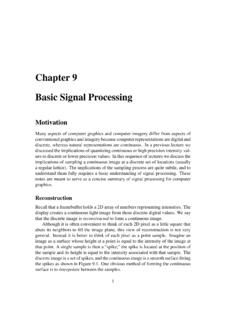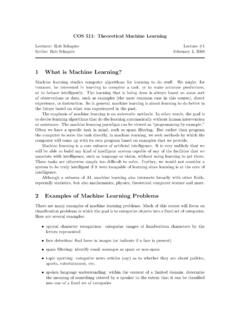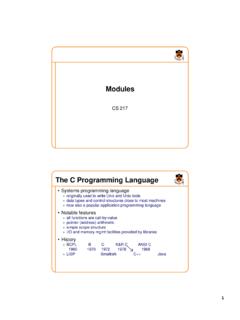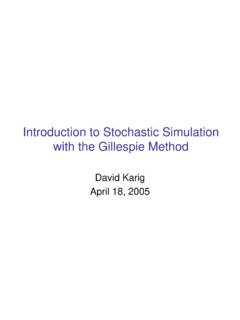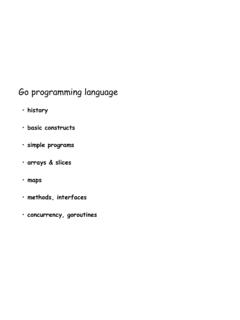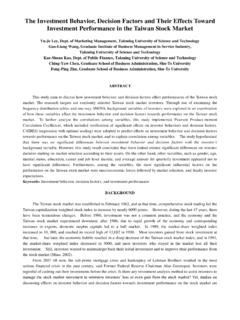Transcription of Predicting Stock Price Direction using Support Vector …
1 Independent Work Report Spring 2015 . Predicting Stock Price Direction using Support Vector Machines Saahil Madge Advisor: Professor Swati Bhatt Abstract Support Vector Machine is a machine learning technique used in recent studies to forecast Stock prices. This study uses daily closing prices for 34 technology stocks to calculate Price volatility and momentum for individual stocks and for the overall sector. These are used as parameters to the SVM model. The model attempts to predict whether a Stock Price sometime in the future will be higher or lower than it is on a given day. We find little predictive ability in the short-run but definite predictive ability in the long-run. 1. Introduction Stock Price prediction is one of the most widely studied and challenging problems, attracting researchers from many fields including economics, history, finance, mathematics, and computer science.
2 The volatile nature of the Stock market makes it difficult to apply simple time-series or regression techniques. Financial institutions and traders have created various proprietary models to try and beat the market for themselves or their clients, but rarely has anyone achieved consistently higher-than-average returns on investment. Nevertheless, the challenge of Stock forecasting is so appealing because an improvement of just a few percentage points can increase profit by millions of dollars for these institutions. Traditionally, many prediction models have focused on linear statistical time series models such as ARIMA [7]. However, the variance underlying the movement of stocks and other assets makes linear techniques suboptimal, and non-linear models like ARCH tend to have lower predictive error [17].
3 Recently, researchers have turned to techniques in the computer science fields of big data and machine learning for Stock Price forecasting. These apply computational power to extend theories in mathematics and statistics. Machine learning algorithms use given data to figure out the solution to a given problem. Big data and machine learning techniques are also the basis for algorithmic and high-frequency trading routines used by financial institutions. In this paper we focus on a specific machine learning technique known as Support Vector Machines (SVM). Our goal is to use SVM at time t to predict whether a given Stock 's Price is higher or lower on day t + m. We look at the technology sector and 34 technology stocks in particular. We input four parameters to the model - the recent Price volatility and momentum of the individual Stock and of the technology sector.
4 These parameters are calculated using daily closing prices for each Stock from the years 2007 through 2014. We analyze whether this historical data can help us predict Price Direction . If the Efficient Markets Hypothesis (EMH) holds true, prices should follow a random walk and be unpredictable based on historical data. We find that in the short-term this holds true, but in the long-term we are able to reach prediction accuracies between 55% and 60%. We conclude that our model is able to achieve significant prediction accuracies with some parameters in the long-term, but that we must look at more granular intra-day trading data to achieve prediction accuracies in the short-term. The code written can be found at 2. Background Information Stock market Efficiency Much economic research has been conducted into the Efficient Markets Hypothesis theory, which posits that Stock prices already reflect all available information [18] and are therefore unpredictable.
5 According to the EMH, Stock prices will only respond to new information and so will follow a random walk. If they only respond to new information, they cannot be predicted. That the stocks follow a random walk is actually a sign of market efficiency, since predictable movement would mean that information was not being reflected by the market prices. There are three variants of this theory weak, semi-strong, and strong. Most research has concluded that the semi-strong version holds true. This version claims that Stock prices reflect all publicly available information, but private information can be used to unfairly predict profits. This is the basis behind strong insider trading laws. Nevertheless, there are certain market phenomena that actually run contrary to EMH. These are known as market anomalies.
6 Jegadeesh and Titman discovered that in the short term, Stock prices tend to exhibit momentum[13]. stocks that have recently been increasing continue to increase, and recently decreasing stocks continue to decrease. This type of trend implies some amount of predictability to future Stock prices, contradicting the EMH. The Stock market also exhibits seasonal trends. Jacobsen and Zhang studied centuries' worth of data and found that trading strategies can exploit trends in high winter returns and low summer returns to beat the market [2][3]. If the EMH held perfectly true, then the Direction of future Stock prices could not be predicted with greater than 50% accuracy. That is, one should not be able to guess whether future prices will go up or down better than simple random guessing. However, the studies discussed in are all able to predict Price Direction with greater than 50% accuracy, implying that machine learning techniques are able to take advantage of momentum and other Price trends to forecast Price Direction .
7 We are able to replicate these results, as discussed in 4. General Machine Learning There are two general classes of machine learning techniques. The first is supervised learning, in which the training data is a series of labeled examples, where each example is a collection of features that is labeled with the correct output corresponding to that feature set [5]. This means that the algorithm is given features and outputs for a particular dataset (training data), and must apply what it learns from this dataset to predict the outputs (labels) for another dataset (test data). Unsupervised learning, on the other hand, consists of examples where the feature set is unlabeled. The algorithms generally try to cluster the data into distinct groups. Supervised learning can be further broken down into classification and regression problems.
8 In classification problems there are a set number of outputs that a feature set can be labeled as, whereas the output can take on continuous values in regression problems. In this paper we treat the problem of Stock Price forecasting as a classification problem. The feature set of a Stock 's recent Price volatility and momentum, along with the index's recent volatility and momentum, are used to predict whether or not the Stock 's Price m days in the future will be higher (+1) or lower ( 1) than the current day's Price . Specifically, we are solving a binary classification problem. 2. Previous Research Most research with machine learning forecasting has focused on Artificial Neural Networks (ANN). [4]. ANNs have a series of interconnected nodes that simulate individual neurons, and are organized into different layers based on function (input layer, processing layer, output layer, etc.)
9 The ANN assigns weights to connections, and the output is calculated based on the inputs and the weights. As the machine trains, it notices patterns in the training data and reassigns the weights. Kar demonstrates that ANNs are quite accurate when the data does not have sudden variations [11]. Patel and Yalamalle agree that ANNs can predict with accuracy slightly greater than 50%, but caution that since Stock market data varies so greatly with time and nonlinearly, prediction is difficult even with advanced techniques like ANNs [12]. Recent research in the field has used another technique known as Support Vector Machines in addition to or as an alternative to ANNs. Whereas ANNs are models that try to minimize classification error within the training data, SVMs may make classification errors within training data in order to minimize overall error across test data.
10 A major advantage of SVMs is that it finds a global optimum, whereas neural networks may only find a local optimum. See for the mathematics behind SVMs. using the SVM model for prediction, Kim was able to predict test data outputs with up to 57%. accuracy, significantly above the 50% threshold [9]. Shah conducted a survey study on Stock prediction using various machine learning models, and found that the best results were achieved with SVM[15]. His prediction rate of 60% agrees with Kim's conclusion. Since most recent research has incorporated SVMs, this is the technique we use in our analysis. Support Vector Machines Support Vector Machines are one of the best binary classifiers. They create a decision boundary such that most points in one category fall on one side of the boundary while most points in the other category fall on the other side of the boundary.
